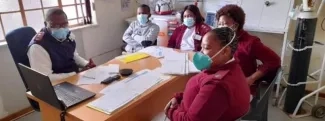Why It Matters
Since March of 2020, South Africa has gone through three COVID-19 lockdowns. According to the World Health Organization, tuberculosis (TB) case notifications fell by more than 40 percent due to reduced TB investigation. Health facilities that usually provide TB care transformed into COVID-19 treatment or isolation centers, and the supply chain for TB diagnostics was disrupted. Improvement Advisors supporting the tuberculosis quality improvement (TBQI) project adapted to a virtual working environment to implement a Sprint model, using “just enough” QI content to foster rapid change. We have used the Sprint model for over a year, aiming to increase case finding by focusing on routine TB testing of groups diagnosed with HIV who are at high risk for TB.
One of us (Dr. Kamoga) coaches and mentors the health facility managers and QI teams, district HIV/TB coordinators, and facility supervisors at 24 public primary health care facilities and two hospitals. On a typical day of visits before the pandemic, he traveled to facilities and worked with mentees for approximately three hours. A typical visit with a QI team involves reviewing how the facility has implemented and documented TB case finding change ideas. Specific challenges are then discussed using a “go and see” approach to determine the source of a problem.

Some coaching sessions used cell phones.
In person, an Improvement Advisor like Dr. Kamoga can physically see the accuracy of source data compared to what is submitted in worksheets documenting the team’s work. For example, in the TB case identification register (record) checklist worksheet, a QI team could report that no TB test results are outstanding. However, a review of the actual registers from different care streams might reveal pending tests. The “go and see” approach also helps the Improvement Advisor to witness patient flow, observe how care activities are conducted, and provide feedback accordingly.
Going Virtual
During the lockdowns, in-person visits became difficult. Teams leveraged technology to continue coaching and mentorship to maintain the significant gains in case finding while also addressing COVID-19. Dr. Kamoga contacted each QI team to determine which video call platform would be most suitable and scheduled two-hour virtual visits. We adapted worksheets and data audit tools from before the pandemic for virtual use. Before each session, the QI teams shared documentation from the previous month in a digital messaging platform.
The virtual visits centered around:
- Review of key TB care cascade metrics using run charts
- Challenges in management of the TB case identification register, as reported in worksheets between visits
- Differences in numbers between key data sources, as reported in the data quality audit tool
- Reasons for gaps in performance of the change ideas tested during the month
- Solutions and amendments to the quality improvement plan for the next four weeks
The teams congregated in a room with no more than five team members per laptop or three around a cell phone, arranged by the facility manager. Two of the 18 sessions switched to a telephone call due to a poor internet connection.
Challenges and Adaptations
The Improvement Advisor could not physically see the source data, such as the TB case identification registers. Instead, he coached each team as they performed the document review and compared source data to submitted worksheets as well as downloads from the electronic record.
Virtually, he couldn’t observe many aspects of care. Instead, he would ask the teams to describe how they conduct an activity. For example, he might say, “Can you take me through the process of collecting a sputum sample for a TB test?”

Due to the COVID-19 pandemic, teams shifted to virtual coaching.
To reduce digital platform fatigue, teams kept virtual visits to less than two hours, which reduced the time for conversation. Since the coach could not observe data verification on telephone calls, those sessions tended to be shorter and focus on performance and gaps based on worksheets and materials exchanged before the call. Giving clear and easy directions for the team’s next steps is especially important in virtual visits. This includes speaking with the QI team lead or a person of influence who will give the other team members information, especially if the virtual visit cannot accommodate the whole team.
In between sessions, in the digital messaging platform, coaches highlight findings from the worksheets, congratulate teams about achievement, and respond to queries. One benefit to the digital messaging platform is that it provides the opportunity for daily check-ins. These digital groups are incredibly active and team leaders are engaged. The groups are designed so team leaders show the way and Improvement Advisors support the system, and we have seen a tremendous increase in participation as we shifted to virtual coaching.
Reflections
Overall, QI teams welcomed the virtual visit experience and worked to prepare for and give succinct feedback during the shorter calls. Virtual support means that teams know that a support visit is just a call away. Of course, not being present means missing some opportunities, such as giving direct feedback to the health worker in their space during a “go and see” visit.
The coaching relationship built over the last 11 months is key to the level of engagement and trust that encourages QI teams to share truthfully what is happening on the ground. To build trust, the project has targeted coaching and mentoring — not fault finding — from the start. Improvement Advisors do not correct team members’ mistakes in the presence of patients or subordinates; rather, they offer respect and give feedback later during an in-person meeting. Similarly, when providing virtual support, they conduct one-on-one calls to coach in private. Making sure team members are part of the project planning and getting their feedback is critical. This work is a partnership. Improvement Advisors ask team members about how they think they are performing and always acknowledge their hard work.
QI teams shared that having their coach available at such a difficult time allowed them to be hopeful in their work. Based on a quick survey, we are now collaborating on plans to use virtual visits for more situations, such as mentorship by district health facility supervisors. We look forward to what is next!
Maureen Fatsani Tshabalala, RNM, BBA, MPH, is a Senior Project Director at IHI. Nelson Kamoga, MBChB, MPH, is an Improvement Advisor at IHI.
You may also be interested in:
